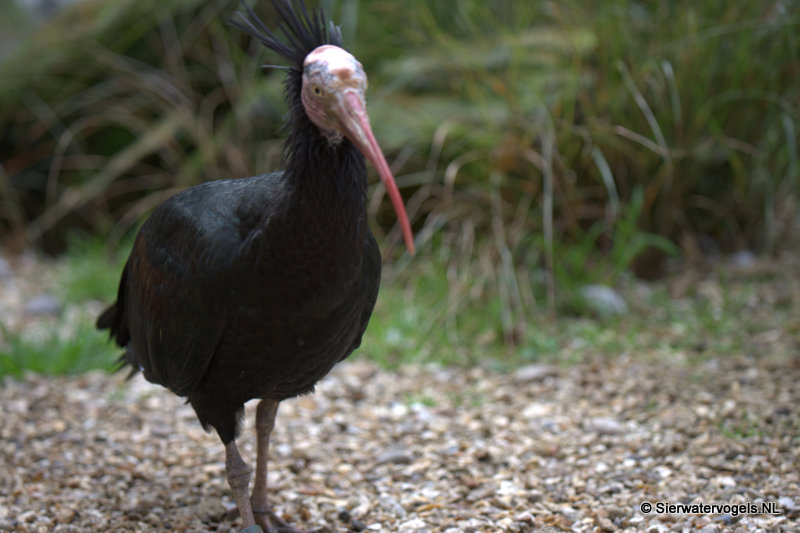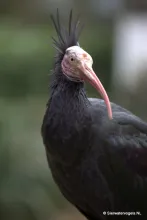
Northern Bald Ibis (Geronticus eremita)
Species name
- Dutch name:
- Noordelijke kaalkopibis
- English name:
- Northern Bald Ibis
- German name:
- Waldrapp
- French name:
- Ibis chauve
- Scientific name:
- Geronticus eremita
Scientific classification
- Order:
- Pelecaniformes
- Family:
- Threskiornithidae
- Genus:
- Geronticus
Description
- Description:
Male:
The plumage is black, with bronze-green and violet iridescence, and there is a wispy ruff on the bird's hind neck. The face and head are dull red and unfeathered, and the long, curved bill and the legs are red. In flight, this bird has powerful, shallow, and flexible wing beats.Female:
The sexes are similar in plumage, although males are generally larger than females, and, as with other ibises that breed in colonies, have longer bills. The longer-billed males are more successful in attracting a mate. Moroccan birds have a significantly longer bill than Turkish birds of the same sex.Juvenile:
The downy chick has uniformly pale brown plumage, and the fledged juvenile resembles the adult except that it has a dark head, light grey legs, and a pale bill. The unfeathered areas of the young bird's head and neck gradually become red as it matures.
Standard Measurements
- Body Length (cm):
- The male (drake) of the Northern Bald Ibis measures approximately 70-80 centimeters. The female measures approximately 70-80 centimeters.
- Body Weight (grams):
- The male will weight about 1000-1300 gram. The female will weight about 1000-1300 gram.
The weight is notoriously variable and can only be used as indication!
- Breeding:
- The female Northern Bald Ibis usually lays from 2-4 white patterned eggs and incubates them for 24-28 days.
- Bird banding:
- Recommended closed leg band ring size for the Northern Bald Ibis is 14 mm.The leg band ring can only be applied on a young ibis at around 14-16 days old.
- It doesn't matter what leg that you band, but it's good to have a consistent system. Suggested: Left leg = Female, Right leg = Male
- Maintenance food:
-




Floating special complete food for sea birds with the highest nutritional requirements thanks to a particularly high protein content of 45%.
Ideal for daily feeding in animals that eat a lot of protein in their natural habitat. A must for "fish eaters".
- Regulation:
- CITES bijlage A
- Regulation:
Deze soorten dienen altijd vergezeld te gaan van een CITES-document. Hierop staat o.a. de geboortedatum, de soortnaam, het geslacht en andere informatie zoals het ringnummer en de diameter van de ring die relevant zijn om het dier te identificeren. Dit internationale paspoort moet altijd bij het dier blijven, waar het ook heengaat.Houders van CITES A soorten dienen een register(boekhouding) bij te houden waarin men o.a. noteert het nummer van het CITES-document, soortnaam, de datum van aankoop en eventuele latere verkoop, verkregen jonge dieren en de datum van overlijden. Een voorbeeld van dit register is te downloaden via www.cites.org.Bij het verkrijgen van nakweek uit CITES A vogels dienen deze geringd te worden met een erkende, geregistreerde ring met een vaststaande diameter. Zolang de nakweek vogels in uw bezit blijven, op het adres dat gelijk is aan dat waar de oudervogels zich bevinden, is een CITES-document voor hen nog niet noodzakelijk.Zodra u de nakweek wilt overdoen aan een andere eigenaar dient u voor de vogels een CITES document aan te vragen. Dit gaat op basis van de CITES documenten van de beide oudervogels. Als de CITES-documenten in uw bezit zijn mag de nakweek uw adres verlaten, NIET eerder! In uw registratie noteert u dan waar de betrokken dieren heengaan.



